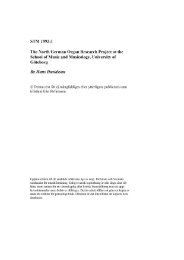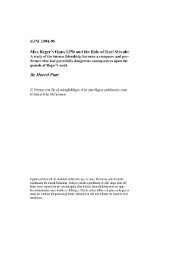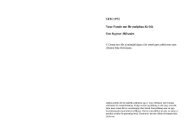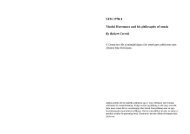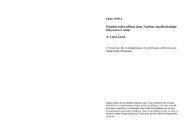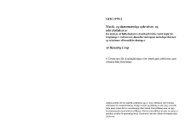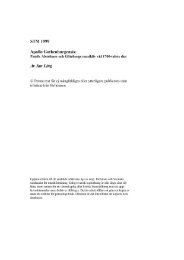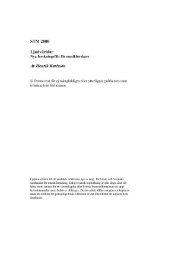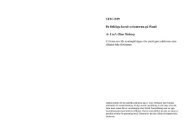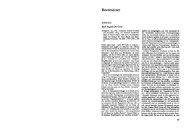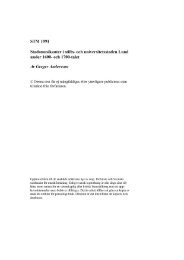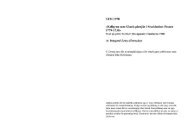Create successful ePaper yourself
Turn your PDF publications into a flip-book with our unique Google optimized e-Paper software.
One is an improvisation of Johann Strauss’ An der schönen blauen Donau (1898;<br />
dedicated to the famous pianist Teresa Carreño). The other is called Fünf Spezialstu-<br />
dien (Bearbeitungen Chopinscher Werke) written in 1899, and published in the same<br />
year; the Strauss transcription was not published until 1930.32 Neither of these<br />
works occurs in the complete Reger edition (which does not include any of Reger’s<br />
arrangements but of his own works); but in vol. 12 of the complete works we find<br />
another piano work (without opus number), Vier Spezialstudien für die linke Hand<br />
allein (1901, including a stunning Prelude and Fugue in e flat minor-for the left<br />
hand only!). As well as the previously mentioned “free arrangements” of Johann<br />
Strauss’ and Frederic Chopin’s compositions they offer a perhaps unique introduc-<br />
tion to many difficult passages in Reger’s organ repertoire. At the same time, they<br />
reveal the very close relationship between Reger’s piano and organ music; one may,<br />
for instance, compare the dense texture in his monumental Introduction, Passacaglia<br />
and Fugue in b minor for 2 pianos (op. 96) with some typical elements in his major<br />
organ works. We know that for many years a lot of the latter were regarded as<br />
impossible to perform in his own indicated tempi. Perhaps one reason was simply<br />
that too many organists at that time had insufficient technique? Most of the organ<br />
works require a good knowledge and command of the advanced piano technique<br />
which has been steadily developed since the days of Liszt and Chopin, and in our<br />
century by composers like Rachmaninov, Sorabji, Boulez or Stockhausen; how<br />
familiar are organists in general with this repertoire?<br />
Before going into further details regarding Straube’s interpretation of Reger, I<br />
want to shed some light on what we know about Reger himself as a performer. In<br />
this context it is interesting to read what Eberhard Otto writes, and quotes, in his<br />
article Max Regers orchestraler Reifestil.33 Otto refers to a certain rehearsal in<br />
Meiningen (on 7 January 1912) where Reger conducted the court orchestra. A<br />
discussion took place about tempi in Brahms’ Fourth Symphony, which was on the<br />
program. According to Reger, the tempi had to be much slower than usual because<br />
of the long reverberation time; if the music was played too fast, Brahms’ polyphony<br />
and harmony would not become clearly perceived. Reger added: “Brahms writes<br />
too often fast tempi . . . because his excitement while composing usually tempted<br />
him to indicate too fast tempi”. The music-loving Duke George II, a patron of fine<br />
arts, and Reger’s immediate employer at that time, made the following comment in<br />
the margin of the letter: “I once asked Brahms why he did not use metronome<br />
markings to have his tempi settled definitively. The composer responded that he<br />
avoided this on purpose, because any tempo may change depending on the conduc-<br />
tor’s mood and feelings”.<br />
32 The Chopin works in question are: Waltz op. 64: i; Waltz op. 42; Impromptu op. 29; Etude op. 25:6;<br />
Waltz op. 64:2.<br />
33 In: “Max Reger: Beiträge zur Regerforschung. Herausgegeben von dem Reger-Festkomitee aus Anlass<br />
der 50. Wiederkehr des Todestages von Max Reger am 11. mai 1966”. Meiningen 1966, p. 90 et seq. The<br />
documentation for his particular matter is found in a letter from Reger, written the same dav to Georg II,<br />
Duke of Sachsen-Meiningen (published in “Max Reger. Briefwechsel mit Herzog Georg II . . . Herausge-<br />
geben von Hedwig und E. H. Müller von Asow”. Weimar 1949, p. 91).<br />
What consequences might this have had for Reger’s own music, and for its<br />
interpretation? It is interesting how the question about his tempi and metronome<br />
markings became a controversial issue from the very beginning, with no definite<br />
answer. In MdMRG Nr. 4, November 1924, we even find (on p. 34) an anonymous<br />
editorial appeal to the readers to supply any information about how Reger used to<br />
perform his own music, especially with regard to tempi. The result of this inquiry-<br />
directed mainly at those who had been studying or performing with him-was to<br />
become documented in a later issue of the same periodical. But nothing seems ever<br />
to have been published; perhaps the answers were too vague to offer more substan-<br />
tial or methodical information. One answer may simply be that some of Reger’s<br />
work feature certain parameters (e.g., density, velocity or dynamics), which are not<br />
so prominent in others, where a more linear counterpoint and less rapid changes of<br />
harmonies dominate the music. Therefore, the whole question of Reger’s tempi<br />
must be related to a thorough analysis of the total structure of individual works,<br />
with regard also to parameters such as harmony, linearity and dynamics.34 To our<br />
knowledge, nobody considered doing such research in the 1920s; in this situation,<br />
Karl Straube was regarded as a most reliable authority, at least for the organ works.<br />
On the other hand, it is hardly possible to discuss these compositions without any<br />
comparison with other Reger works for piano, choir, orchestra, solo voice or<br />
chamber ensembles. In an article in the same November 1924 issue of MdMRG, a<br />
former Reger student and musicologist, Emanuel Gatscher, reminds organists of the<br />
importance of having a perfect piano technique, to be able to perform Reger’s<br />
difficult organ works.35 Gatscher also mentions in the same article that terms like<br />
vivacissimo or adagissimo have less to do with real tempi than with the character of<br />
the work in question. Likewise, crescendo, stringendo, diminuendo and rallentando<br />
refer more to a general tempo rubato within a large overall structure than to<br />
exaggerated contrasts: the large structure must always be clearly rendered and it is<br />
most important that the performer conveys the idea of a basic melos. Gatscher also<br />
points out that one should not even try to apply identical performance practices to<br />
different pieces in the same genre (neither are all Phantasies alike, nor all the<br />
Fugues); rather it is necessary to find the appropriate character in each work;<br />
monumental compositions require a monumental interpretation. Gatscher’s remarks<br />
about Reger’s music seem to correspond almost exactly to what Straube wrote 20<br />
years earlier, in the preface to Alte Meister about his search for the right mood in<br />
each of the fourteen selected baroque compositions.<br />
In this context, it is interesting to compare the result of all questions about<br />
Reger’s tempi and dynamics (both his own, and Straube’s) with some comments<br />
which the late conductor Hermann Scherchen made about Anton Webern’s music.36<br />
34 Cf. Thomas-Martin Langner: Studien ZUT Dynamik Max Regers. Diss., Berlin 1952 (typewritten).<br />
Strangely enough, almost no attention is paid to Reger’s organ music there!<br />
35 “Einige Bemerkungen zum Studium Regerscher Orgelwerke”; op. cit. p. 2-8.<br />
36 During an interview which I had with him in Stockholm, November 1955, in connection with the<br />
Webern Festival; the interview was published in the program booklet for this occasion by Stockholms<br />
Konsertförening (The Stockholm Concert Society).



